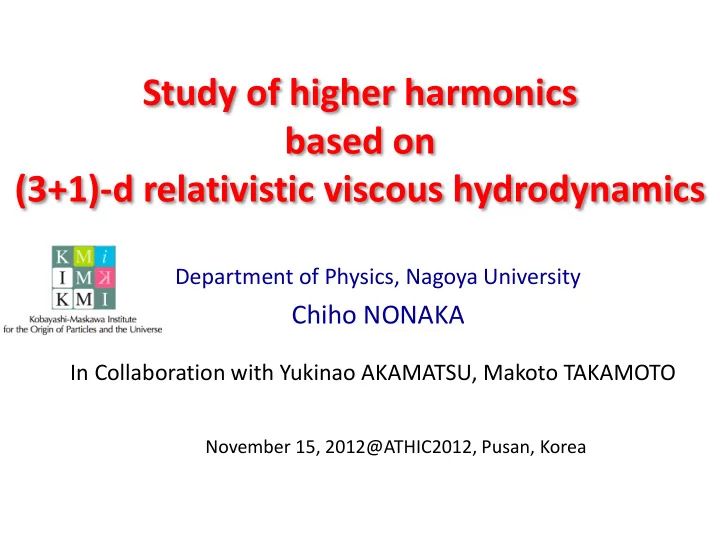

Study of higher harmonics based on (3+1)-d relativistic viscous hydrodynamics Department of Physics, Nagoya University Chiho NONAKA In Collaboration with Yukinao AKAMATSU, Makoto TAKAMOTO November 15, 2012@ATHIC2012, Pusan, Korea
Time Evolution of Heavy Ion Collisions hydro hadronization freezeout collisions thermalization observables higher harmonics strong elliptic flow @RHIC particle yields: P T distribution model fluctuating hydrodynamic model final state interactions: initial conditions hadron base Viscosity, Shock wave event generators C. NONAKA
Higher Harmonics • Higher harmonics and Ridge structure Mach-Cone-Like structure, Ridge structure Challenge to relativistic hydrodynamic model Viscosity effect from initial e n to final v n Longitudinal structure (3+1) dimensional Higher harmonics high accuracy calculations State-of-the-art numerical algorithm • Shock-wave treatment • Less numerical viscosity C. NONAKA
Viscous Hydrodynamic Model • Relativistic viscous hydrodynamic equation – First order in gradient: acausality – Second order in gradient: systematic treatment is not established • Israel-Stewart • Ottinger and Grmela • AdS/CFT • Grad’s 14 -momentum expansion • Renomarization group • Numerical scheme – Shock-wave capturing schemes C. NONAKA
Numerical Scheme • Lessons from wave equation – First order accuracy: large dissipation – Second order accuracy : numerical oscillation -> artificial viscosity, flux limiter • Hydrodynamic equation – Shock-wave capturing schemes: Riemann problem • Godunov scheme: analytical solution of Riemann problem, Our scheme • SHASTA: the first version of Flux Corrected Transport algorithm, Song, Heinz, Chaudhuri • Kurganov-Tadmor (KT) scheme, McGill C. NONAKA
Current Status of Hydro Ideal C. NONAKA
Our Approach Takamoto and Inutsuka, arXiv:1106.1732 • Israel-Stewart Theory (ideal hydro) 1. dissipative fluid dynamics = advection + dissipation exact solution Riemann solver: Godunov method Contact discontinuity Rarefaction wave Shock wave Two shock approximation Mignone, Plewa and Bodo, Astrophys. J. S160, 199 (2005) Rarefaction wave shock wave Akamatsu, Nonaka, Takamoto, Inutsuka, in preparation 2. relaxation equation = advection + stiff equation C. NONAKA
Numerical Scheme • Israel-Stewart Theory Takamoto and Inutsuka, arXiv:1106.1732 1. Dissipative fluid equation 2. Relaxation equation + stiff equation advection I: second order terms C. NONAKA
Relaxation Equation Takamoto and Inutsuka, arXiv:1106.1732 • Numerical scheme + stiff equation advection • during D t up wind method ~constant Piecewise exact solution fast numerical scheme C. NONAKA
Comparison • Shock Tube Test : Molnar, Niemi, Rischke, Eur.Phys.J.C65,615(2010) • Analytical solution T=0.4 GeV EoS: ideal gas • Numerical schemes v=0 SHASTA, KT, NT Our scheme T=0.2 GeV v=0 0 10 Nx=100, dx=0.1 C. NONAKA
Energy Density t=4.0 fm dt=0.04, 100 steps analytic C. NONAKA
Velocity t=4.0 fm dt=0.04, 100 steps analytic C. NONAKA
q t=4.0 fm dt=0.04, 100 steps analytic C. NONAKA
Artificial and Physical Viscosities Molnar, Niemi, Rischke, Eur.Phys.J.C65,615(2010) Antidiffusion terms : artificial viscosity stability C. NONAKA
Viscosity Effect C. NONAKA
EoS Dependence C. NONAKA
To Multi Dimension • Operational split and directional split Operational split (C, S) C. NONAKA
To Multi Dimension • Operational split and directional split Operational split (C, S) 2d 3d L i : operation in i direction C. NONAKA
Higher Harmonics • Initial conditions – Gluaber model smoothed fluctuating C. NONAKA
Higher Harmonics • Initial conditions at mid rapidity – Gluaber model smoothed fluctuated t=10 fm t=10 fm C. NONAKA
Time Evolution of v n Smoothed IC Fluctuating IC v n becomes finite. v 2 is dominant. C. NONAKA
Time Evolution of Higher Harmonics Petersen et al, Phys.Rev. C82 (2010) 041901 Ideal hydrodynamic calculation at mid rapidity e n , v n : Sum up with entropy density weight EoS: ideal gas C. NONAKA
14 Viscosity Effect fm -4 initial Pressure distribution t~10 fm t~15 fm Ideal t~5 fm 1 1 7 Viscosity 0.9 7 0.25 C. NONAKA
fm -4 20 Viscous Effect initial Pressure distribution t~10 fm t~15 fm Ideal t~5 fm fm -4 0.25 1.2 9 Viscosity 0.3 1.2 9 C. NONAKA
Summary • We develop a state-of-the-art numerical scheme – Viscosity effect – Shock wave capturing scheme: Godunov method Our algorithm – Less artificial diffusion: crucial for viscosity analyses – Fast numerical scheme • Higher harmonics – Time evolution of e n and v n • Work in progress – Comparison with experimental data Akamatsu C. NONAKA
Backup C. NONAKA
Numerical Method Takamoto and Inutsuka, arXiv:1106.1732 SHASTA, rHLLE, KT C. NONAKA
2D Blast Wave Check t=0 Pressure const. Velocity vectors ( t=0) Velocity |v|=0.9 Shock wave 50 steps 1000 steps 100 steps 500 steps Numerical scheme, in preparation Akamatsu, Nonaka and Takamoto Application to Heavy Ion collisions At QM2012!! C. NONAKA
rHLLE vs SHASTA Schneider et al. J. Comp.105(1993)92 C. NONAKA
Recommend
More recommend